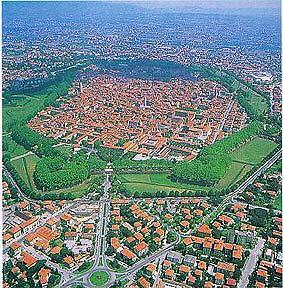


All the structures

Lucca is situated 19 m. above sea level on an alluvial plateau, to the left of the Serchio river, not far from the Tyrrhenian coast. An important road junction in Roman times, Lucca was the capital of the Lombard Duchy of Tuscia and subsequently (8th century) the seat of the Carolingian Marquisate of Tuscany. Established as a free municipality (early 12th century), the town grew in political and economical importance, though it was often troubled by internal disputes and rivalry with Pisa. In the first half of the 14th century, it was under various Signorie and in 1369 it became a Republic remaining independent, except during the Guinigi Signorie (1400-1430) and the Napoleonic period, until 1847 when it was included in the Grand Duchy of Tuscany, from then on sharing its fortunes.
The town lies within a circle of 16th century walls which, in the 19th century, were transformed into a tree-lined avenue; it has therefore maintained its characteristic medieval structure.
Monuments: Duomo (11th-13th century, Romanesque) housing the Tomb of Ilaria del Carretto, a sculptural masterpiece by Jacopo della Quercia (1408), church of S. Maria Foris portam (13th-16th century), Case dei Guinigi (a complex of 14th century towers and buildings), church of S. Michele in Foro (12th-13th century, Pisan-Lucca architecture with a rich interior), church of S. Frediano (12th century, Romanesque, with a large mosaic of the Ascension, 13th century on the façade), Palazzo Mansi (17th century), Palazzo Pretorio (16th century), Villa of Paolo Guinigi (15th century), remains of the Roman amphitheatre (structure of the present Piazza del Mercato).
Lucca's economy is based on agricultural produce from the fertile surrounding countryside (olives, fruit, cereals, grapes) and the town acts as a commercial and transformation centre (oil mills). Industry is traditionally present in textiles and clothing but there are also chemical, engineering and building firms.
Famous People: Luigi Boccherini (musician, 1743-1805), Giacomo Puccini (musician, 1858-1924), Francesco Carrara (jurist, 1805-1888), Matteo Civitali (sculptor and architect, 1436-1501), Bonagiunta Orbiciani (poet, 1230-1300).
Cultural Institutions: Academy of Lucca of Science, Letters and Arts, National Museum of Villa Guinigi, National Art Gallery, libraries, Giglio Theatre.
In the Province: Viareggio (seaside resort, famous carnival), Pietrasanta, Camaiore, Forte dei Marmi.